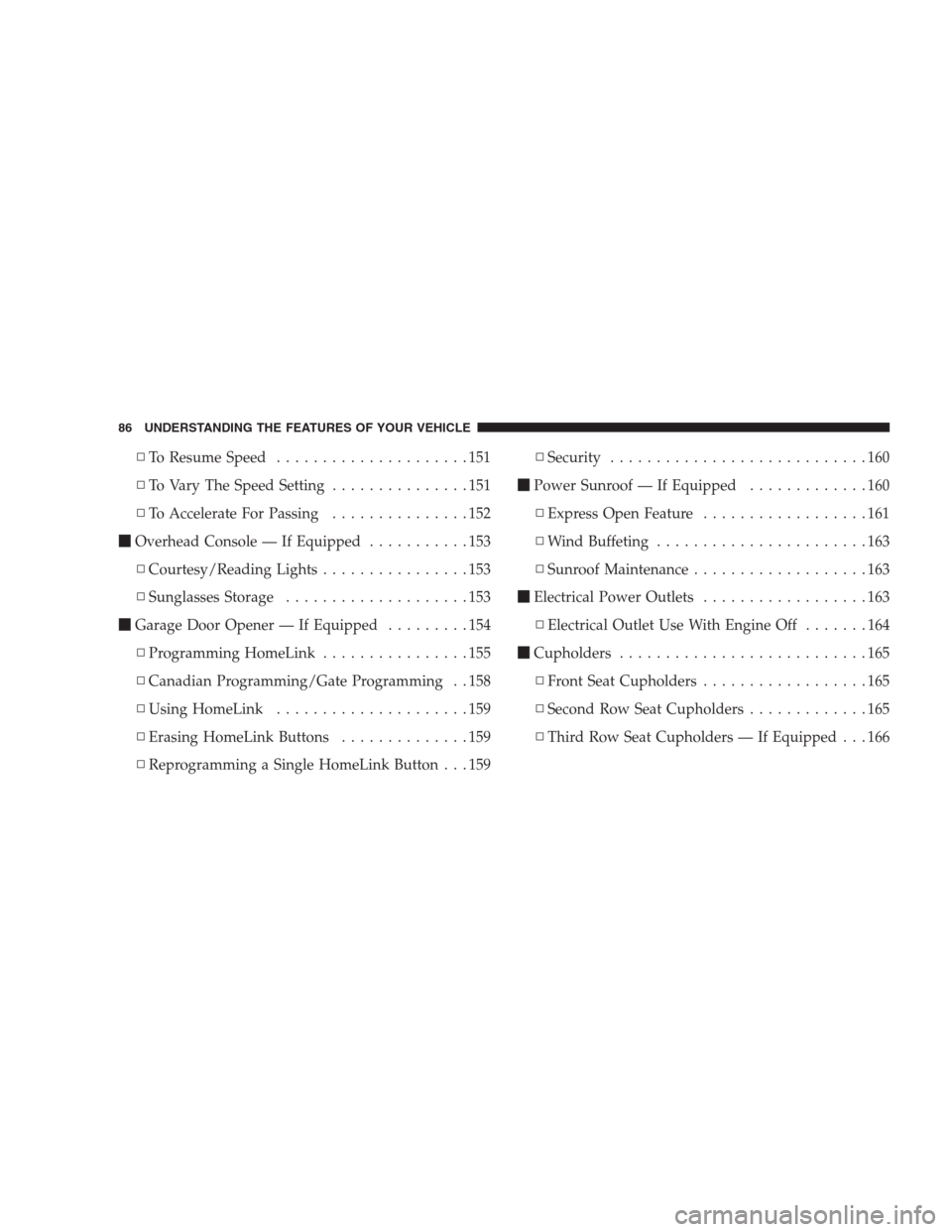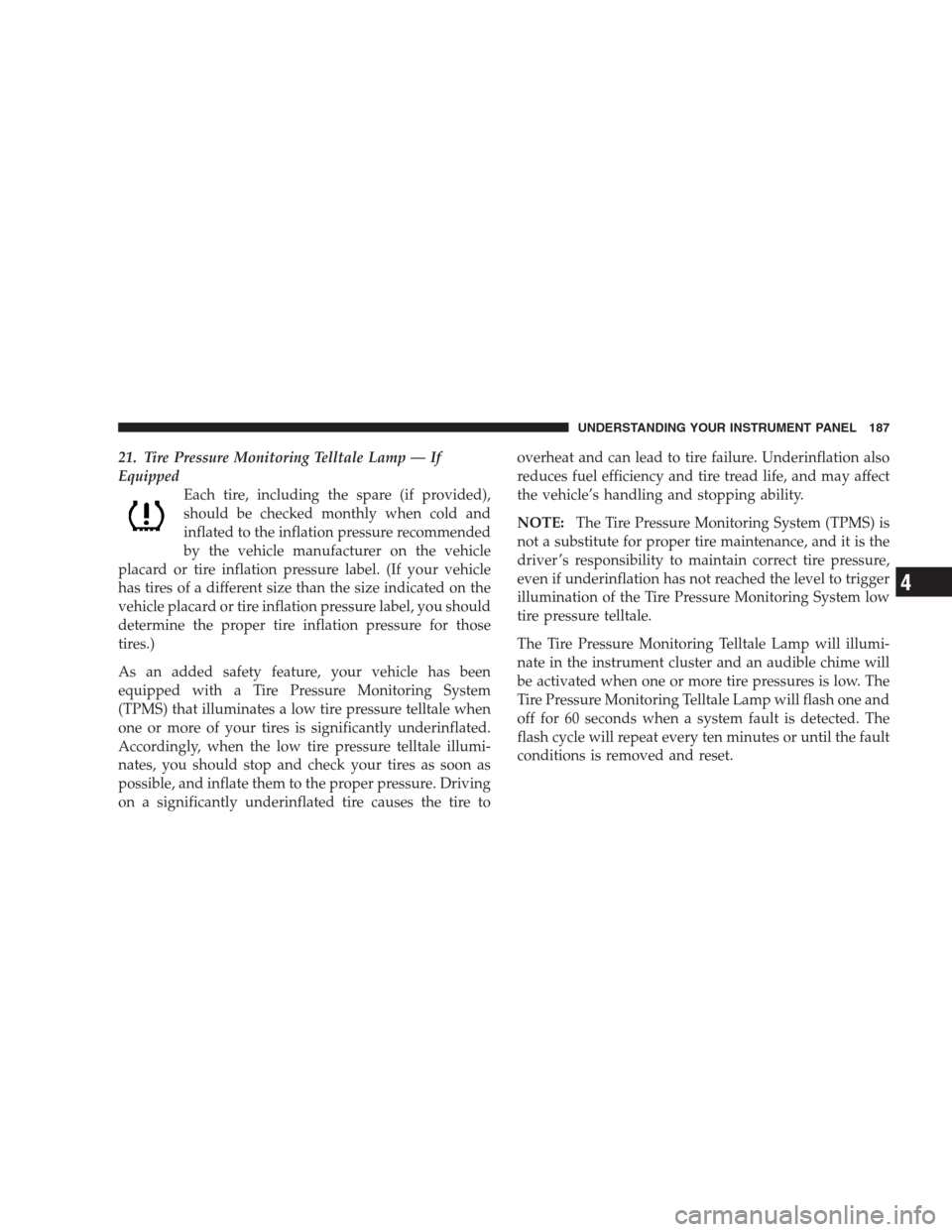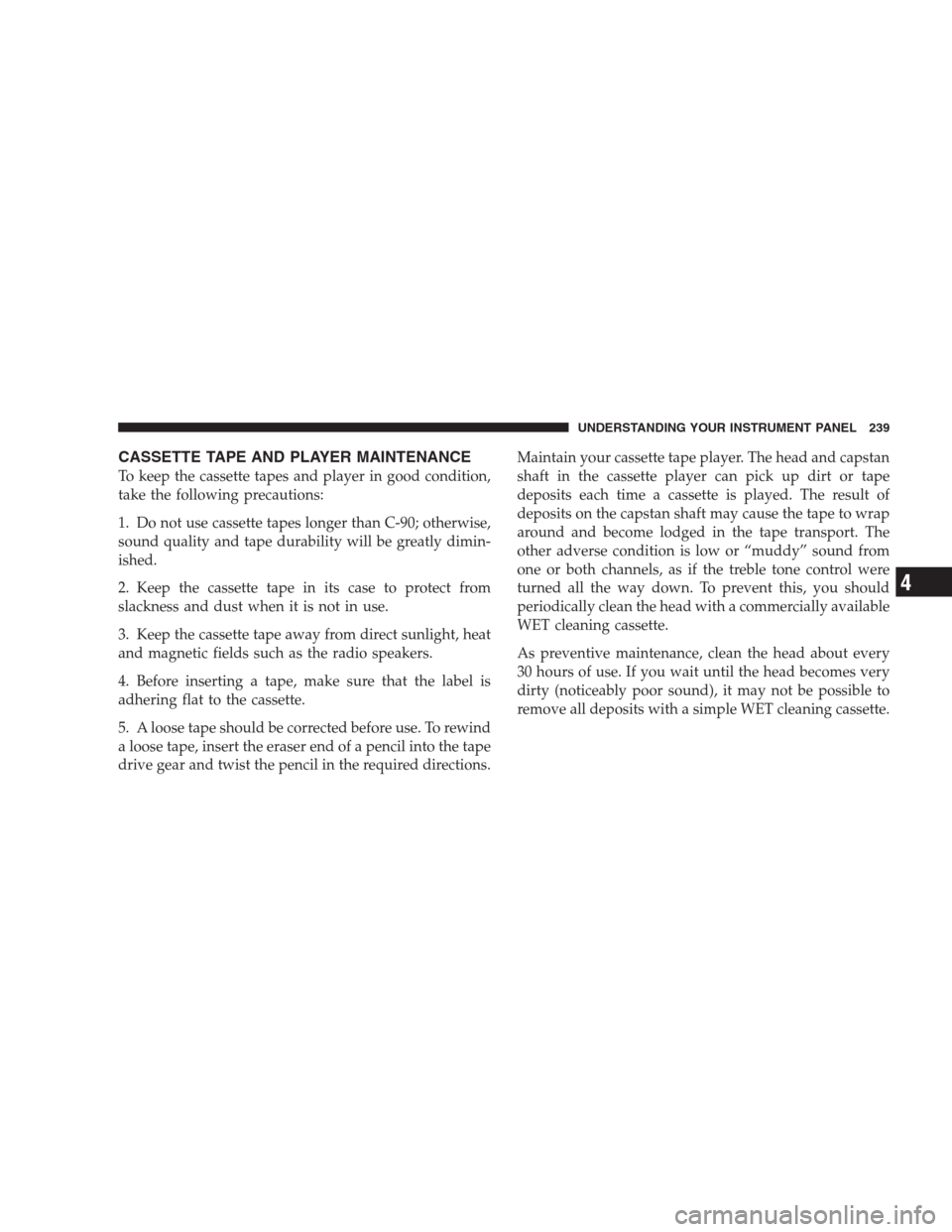Page 1 of 464
TABLE OF CONTENTSSECTIONPAGE
1INTRODUCTION.............................................................3
2THINGS TO KNOW BEFORE STARTING YOUR VEHICLE..............................9
3UNDERSTANDING THE FEATURES OF YOUR VEHICLE..............................83
4UNDERSTANDING YOUR INSTRUMENT PANEL...................................173
5STARTING AND OPERATING.................................................261
6WHAT TO DO IN EMERGENCIES..............................................343
7MAINTAINING YOUR VEHICLE...............................................361
8MAINTENANCE SCHEDULES..................................................415
9IF YOU NEED CONSUMER ASSISTANCE.........................................437
10INDEX....................................................................445
1
2
3
4
5
6
7
8
9
10
Page 4 of 464

INTRODUCTION
This manual has been prepared with the assistance of
service and engineering specialists to acquaint you with
the operation and maintenance of your new vehicle. It is
supplemented by a Warranty Information Booklet and
various customer oriented documents. You are urged to
read these publications carefully. Following the instruc-
tions and recommendations in this manual will help
assure safe and enjoyable operation of your vehicle.
NOTE: After you read the manual, it should be stored
in the vehicle for convenient reference and remain with
the vehicle when sold, so that the new owner will be
aware of all safety warnings.
When it comes to service, remember that your dealer
knows your vehicle best, has the factory-trained techni-
cians and genuine Mopar�parts, and is interested in
your satisfaction.WARNING!
Engine exhaust, some of its constituents, and certain
vehicle components contain or emit chemicals
known to the State of California to cause cancer and
birth defects or other reproductive harm. In addition,
certain fluids contained in vehicles and certain prod-
ucts of component wear contain or emit chemicals
known to the State of California to cause cancer and
birth defects or other reproductive harm.
HOW TO USE THIS MANUAL
Consult the table of contents to determine which section
contains the information you desire.
The detailed index, at the rear of this manual, contains a
complete listing of all subjects.
Consult the following table for a description of the
symbols that may be used on your vehicle or throughout
this owner’s manual:
4 INTRODUCTION
Page 86 of 464

▫To Resume Speed.....................151
▫To Vary The Speed Setting...............151
▫To Accelerate For Passing...............152
�Overhead Console — If Equipped...........153
▫Courtesy/Reading Lights................153
▫Sunglasses Storage....................153
�Garage Door Opener — If Equipped.........154
▫Programming HomeLink................155
▫Canadian Programming/Gate Programming . . 158
▫Using HomeLink.....................159
▫Erasing HomeLink Buttons..............159
▫Reprogramming a Single HomeLink Button . . . 159▫Security............................160
�Power Sunroof — If Equipped.............160
▫Express Open Feature..................161
▫Wind Buffeting.......................163
▫Sunroof Maintenance...................163
�Electrical Power Outlets..................163
▫Electrical Outlet Use With Engine Off.......164
�Cupholders...........................165
▫Front Seat Cupholders..................165
▫Second Row Seat Cupholders.............165
▫Third Row Seat Cupholders — If Equipped . . . 166
86 UNDERSTANDING THE FEATURES OF YOUR VEHICLE
Page 163 of 464

Wind Buffeting
Wind buffeting can be described as the perception of
pressure on the ears or a helicopter type sound in the
ears. Your vehicle may exhibit wind buffeting with the
windows down, or the sunroof (if equipped) in certain
open or partially open positions. This is a normal occur-
rence and can be minimized. If the buffeting occurs with
the rear windows open, open the front and rear windows
together to minimize the buffeting. If the buffeting occurs
with the sunroof open, adjust the sunroof opening to
minimize the buffeting or open any window.
Sunroof Maintenance
Use only a non-abrasive cleaner and a soft cloth to clean
the glass panel.
ELECTRICAL POWER OUTLETS
There are two 12 volt power outlets located on the instru-
ment panel below the radio. The driver’s side outlet is
controlled by the ignition switch and the passenger side
outlet is connected directly to the battery. The driver’s side
outlet will also operate a conventional cigar lighter unit (if
equipped with an optional Smoker’s Package).
Front Power Outlets
UNDERSTANDING THE FEATURES OF YOUR VEHICLE 163
3
Page 175 of 464

�Satellite Radio — If Equipped..............233
▫System Activation.....................234
▫Electronic Serial Number/Sirius Identification
Number (ENS/SID)....................234
▫Selecting Satellite Mode In RBB, RAH And
RBK Radios.........................235
▫Selecting Satellite Mode In RBP, RBU, RAZ,
RB1 And RBQ Radios..................235
▫Selecting a Channel....................235
▫Storing And Selecting Pre-Set Channels......236
▫Using The PTY (Program Type) Button
(If Equipped)........................236
▫PTY Button�Scan�.....................236
▫PTY Button�Seek�.....................236▫Satellite Antenna......................237
▫Reception Quality.....................237
�Remote Sound System Controls.............237
▫Radio Operation......................238
▫Tape Player.........................238
▫CD Player..........................238
�Cassette Tape And Player Maintenance.......239
�CD/DVD Disc Maintenance...............240
�Radio Operation And Cellular Phones........240
�Climate Controls.......................240
▫Manual Air Conditioning And Heating
System.............................241
▫Mode Control........................242
UNDERSTANDING YOUR INSTRUMENT PANEL 175
4
Page 187 of 464

21. Tire Pressure Monitoring Telltale Lamp — If
Equipped
Each tire, including the spare (if provided),
should be checked monthly when cold and
inflated to the inflation pressure recommended
by the vehicle manufacturer on the vehicle
placard or tire inflation pressure label. (If your vehicle
has tires of a different size than the size indicated on the
vehicle placard or tire inflation pressure label, you should
determine the proper tire inflation pressure for those
tires.)
As an added safety feature, your vehicle has been
equipped with a Tire Pressure Monitoring System
(TPMS) that illuminates a low tire pressure telltale when
one or more of your tires is significantly underinflated.
Accordingly, when the low tire pressure telltale illumi-
nates, you should stop and check your tires as soon as
possible, and inflate them to the proper pressure. Driving
on a significantly underinflated tire causes the tire tooverheat and can lead to tire failure. Underinflation also
reduces fuel efficiency and tire tread life, and may affect
the vehicle’s handling and stopping ability.
NOTE:The Tire Pressure Monitoring System (TPMS) is
not a substitute for proper tire maintenance, and it is the
driver ’s responsibility to maintain correct tire pressure,
even if underinflation has not reached the level to trigger
illumination of the Tire Pressure Monitoring System low
tire pressure telltale.
The Tire Pressure Monitoring Telltale Lamp will illumi-
nate in the instrument cluster and an audible chime will
be activated when one or more tire pressures is low. The
Tire Pressure Monitoring Telltale Lamp will flash one and
off for 60 seconds when a system fault is detected. The
flash cycle will repeat every ten minutes or until the fault
conditions is removed and reset.
UNDERSTANDING YOUR INSTRUMENT PANEL 187
4
Page 239 of 464

CASSETTE TAPE AND PLAYER MAINTENANCE
To keep the cassette tapes and player in good condition,
take the following precautions:
1. Do not use cassette tapes longer than C-90; otherwise,
sound quality and tape durability will be greatly dimin-
ished.
2. Keep the cassette tape in its case to protect from
slackness and dust when it is not in use.
3. Keep the cassette tape away from direct sunlight, heat
and magnetic fields such as the radio speakers.
4. Before inserting a tape, make sure that the label is
adhering flat to the cassette.
5. A loose tape should be corrected before use. To rewind
a loose tape, insert the eraser end of a pencil into the tape
drive gear and twist the pencil in the required directions.Maintain your cassette tape player. The head and capstan
shaft in the cassette player can pick up dirt or tape
deposits each time a cassette is played. The result of
deposits on the capstan shaft may cause the tape to wrap
around and become lodged in the tape transport. The
other adverse condition is low or “muddy” sound from
one or both channels, as if the treble tone control were
turned all the way down. To prevent this, you should
periodically clean the head with a commercially available
WET cleaning cassette.
As preventive maintenance, clean the head about every
30 hours of use. If you wait until the head becomes very
dirty (noticeably poor sound), it may not be possible to
remove all deposits with a simple WET cleaning cassette.
UNDERSTANDING YOUR INSTRUMENT PANEL 239
4
Page 240 of 464

CD/DVD DISC MAINTENANCE
To keep the CD/DVD discs in good condition, take the
following precautions:
1. Handle the disc by its edge; avoid touching the
surface.
2. If the disc is stained, clean the surface with a soft cloth,
wiping from center to edge.
3. Do not apply paper, paper CD labels, or tape to the
disc; avoid scratching the disc.
4. Do not use solvents such as benzine, thinner, cleaners,
or antistatic sprays.
5. Store the disc in its case after playing.
6. Do not expose the disc to direct sunlight.
7. Do not store the disc where temperatures may become
too high.
RADIO OPERATION AND CELLULAR PHONES
Under certain conditions, the cellular phone being On in
your vehicle can cause erratic or noisy performance from
your radio. This condition may be lessened or eliminated
by relocating the cellular phone antenna. This condition
is not harmful to the radio. If your radio performance
does not satisfactorily “clear” by the repositioning of the
antenna, it is recommended that the radio volume be
turned down or off during cellular phone operation.
CLIMATE CONTROLS
The Air Conditioning and Heating System is designed to
make you comfortable in all types of weather.
240 UNDERSTANDING YOUR INSTRUMENT PANEL